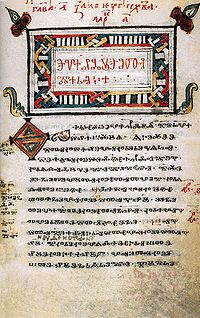- Codex Zographensis
-
The Codex Zographensis (Bulgarian: Зографско евангелие and Russian: Зографское евангелие) is an illuminated manuscript Gospel Book that was found in the Bulgarian Zograf Monastery on Mount Athos in 1843 by Croatian writer and diplomat Antun Mihanović, and which dates from the late 10th or early 11th century.
Along with the slightly older Codex Marianus it is an important document for its use of the round Glagolitic script, the oldest recorded Slavic alphabet. Codex is also a part of the Old Church Slavonic canon, exhibiting linguistic features of the Western Bulgarian (Macedonian) provenience.[1]
The manuscript contains 304 parchment folios, of which the foremost have not been preserved, and thus begins with Matthew 3:11. The first 288 folios are written in Glagolitic and contain the Gospel text. In addition, several additional folios from the middle of the manuscript are missing. At the end of the 11th or beginning of the 12th century some missing folios (from 41 to 57) were replaced with 17 new ones, written in square Glagolitic. They were themselves most likely a palimpsest. The rest of the 16 folios contain 13th-century synaxarium.
Codex's existence was made public by Izmail Sreznevsky in 1856. In 1860 Monks from the Zograf monastery gifted the Codex to Russian emperor Alexander II who donated it to Russian National Library, where the Codex is being kept today. Parts of Codex Zographensis were published by Russian linguist Izmail Sreznevsky in 1856.[2] The first to describe the codex was Viktor I. Grigorovič in 1877, and two years later the Glagolitic part of the codex was published in edition of Croatian Slavist Vatroslav Jagić in Berlin as Quattuor evangeliorum codex glagoliticus olim Zographensis nunc Petropolitanus, completely transcribed in Cyrillic, with introduction and extensive philological commentary in Latin. Jagić's edition has been republished in Graz in 1954. Other scholars who have extensively studied the language of Codex Zographensis include the Czech Josef Kurz and the Pole Leszek Moszyński.
Analysing the language of the codex it was established that the style and antiquity of the text is nonuniform, second part being more archaic than the first part. Some scholars explain this by gradual adaptation to the language of the source whence manuscript originated. Generally, phonology of the language of Codex Zographensis is very archaic - vocalizations of strong yers are rare, epenthetic l is preserved, though in the most parts of the manuscript yers are being assimilated. It is a bit less archaic with respect to morphology and syntax, though the forms of definite declension of adjectives and older forms of participles are well-preserved (e.g. prošь, nošь and rarely prosivъ, nosivъ).
Contents
Gallery
Footnotes
- ^ "Altkirchenslawische Quellen: Der Codex Zographensis" (in German). KODEKS at the Otto-Friedrich University website. http://kodeks.uni-bamberg.de/AKSL/Quellen/AKSL.CdxZographensis.htm. Retrieved 2006-07-10.
- ^ Кирилометодиевска енциклопедия, т. І, София 1985, с. 739-740
References
- Jagić, V. (1879). Quattuor evangeliorum Codex glagoliticus olim Zographensis nunc Petropolitanus. Berolini. http://www.archive.org/details/quattuorevangeli00jagiuoft.
- Damjanović, Stjepan (2003). Staroslavenski jezik. Zagreb: Hrvatska sveučilišna naklada. ISBN 953-169-095-2.
- Schenker, Alexander (1995). The Dawn of Slavic: An Introduction to Slavic Philology. New Haven: Yale University Press. ISBN 0-30005-846-2.
- "Altkirchenslawische Quellen: Der Codex Zographensis" (in German). KODEKS at the Otto-Friedrich University website. http://kodeks.uni-bamberg.de/AKSL/Quellen/AKSL.CdxZographensis.htm. Retrieved 2006-07-10.
Further reading
- V. Jagić: Studien über das altslovenische Zographosevangelium. Archiv für slavische Philologie I, II, 1876-1877.
- N. Grunskij: K Zografskomu evangeliju. In: Sbornik Otdelenija russkogo jazyka i slovesnosti Akademii Nauk LXXXIII, No. 3, 1907.
- N. van Wijk: Palaeoslovenica. I. O prototypie cerkiewno-sl/owian'skiego "Codex Zographensis". Rocznik Slawistyczny IX, 1921.
- N. van Wijk: Ešče raz o Zografskom četveroevangelii. Slavia I, 1922/23.
- J. Kurz: K Zografskému evangeliu. Slavia IX, 1930/31, XI, 1932.
External links
- Codex Zographensis transliterated in 7-bit ASCII, at the Corpus Cyrillo-Methodianum Helsingiense
Categories:- Gospel Books
- Medieval Bulgarian literature of Macedonia
- Biblical manuscripts
- Old Church Slavonic canon
- Athos manuscripts
- National Library of Russia collection
- 10th-century biblical manuscripts
- 11th-century biblical manuscripts
- 10th-century illuminated manuscripts
- 11th-century illuminated manuscripts
Wikimedia Foundation. 2010.



